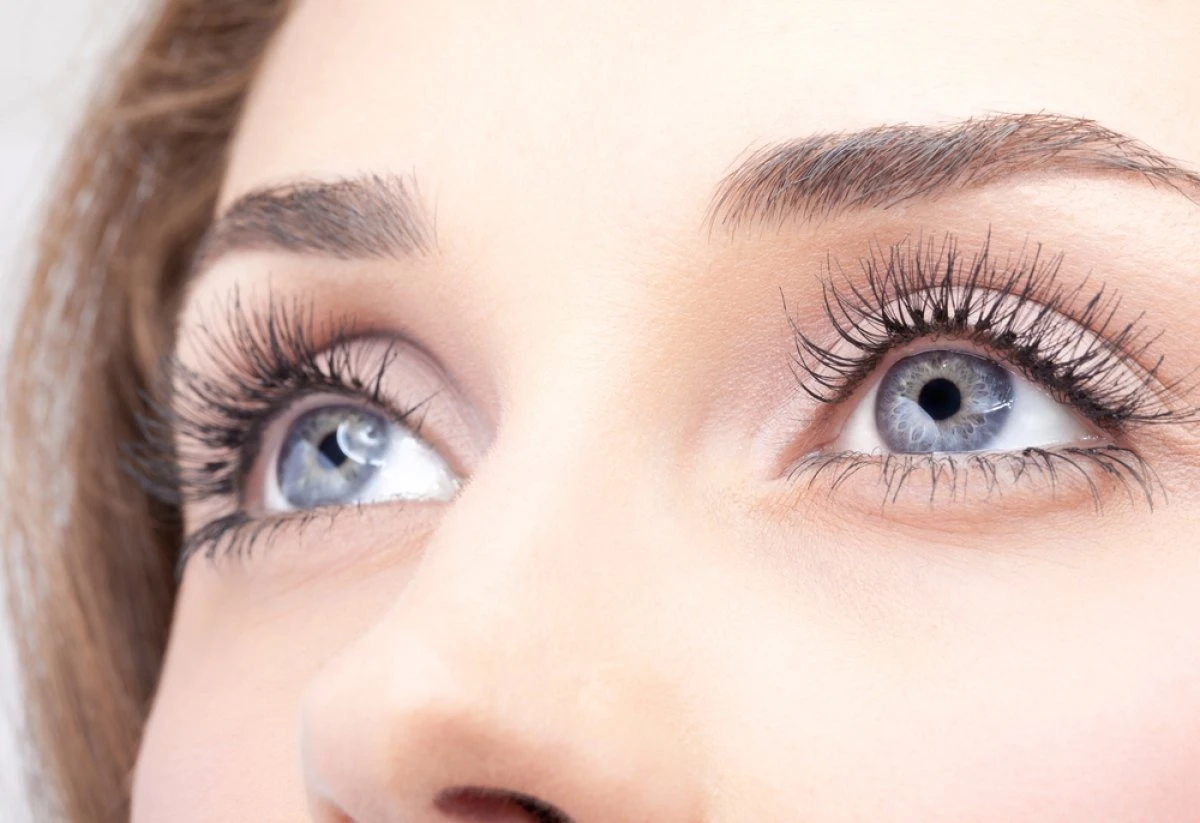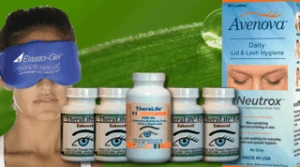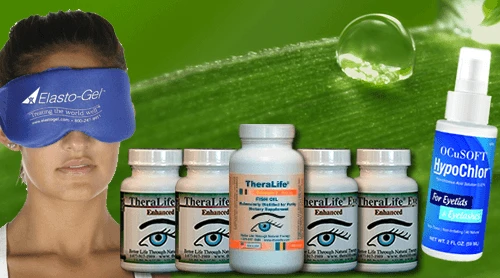During menopause, decreased estrogen and androgen levels can disrupt the function of the lacrimal and meibomian glands, reducing tear and lipid secretion. This hormonal imbalance compromises tear film stability, leading to increased evaporation, reduced ocular lubrication, and chronic dry eye symptoms such as burning, gritty sensations, and light sensitivity. Aging further amplifies these effects, making dry eyes more common in menopausal women.
TheraLife’s products offer a unique solution to these issues. As the only company providing oral eye treatment care, TheraLife focuses on improving tear function from within. Their comprehensive approach targets the underlying causes of dry eyes, enhancing comfort and ocular health. By addressing hormonal imbalances and gland dysfunction, TheraLife products can significantly improve the quality of life for those suffering from dry eyes during menopause.
Effective Treatment for Menopause And Dry Eyes
To treat MN- there are options for synthetic hormones – which is very effective in relieving symptoms of menopause. However, it carries the risk of ovarian cancer for those prone. There is a natural alternative for MN relief based on soy extracts called Isoflavones.
Menopausal Support
An effective oral dry eye treatment that works.
Key Takeaways
- Hormonal fluctuations during menopause, especially declining estrogen, disrupt tear production and stability.
- Reduced estrogen and androgen levels decrease secretion from lacrimal and meibomian glands, leading to dry eyes.
- Menopausal hormonal changes increase tear evaporation and surface inflammation, causing persistent eye irritation.
- Age-related factors compound hormonal effects, making menopausal women more susceptible to dry eye symptoms.
- Environmental and lifestyle factors, such as screen use and poor diet, further worsen dry eyes during menopause.
Understanding the Role of Hormones in Eye Health

Although hormones regulate numerous physiological processes, their influence on ocular health is often underestimated. You mightn’t realize that hormonal fluctuations can directly affect eye moisture by altering lacrimal gland function and meibomian gland secretions.
Estrogen, progesterone, and androgens possess receptors in ocular tissues, where they modulate tear film composition and stability. When hormone levels shift, as they do throughout life, the balance of aqueous, lipid, and mucin layers in your tear film can become disrupted.
This leads to changes in tear production, evaporation rates, and ocular surface integrity. Clinical studies demonstrate that even minor hormonal fluctuations may compromise the ocular surface, increasing your susceptibility to dryness, irritation, and inflammation.
Understanding this connection is essential for recognizing how systemic endocrine changes can manifest as ocular symptoms. Menopause symptoms in women correlate with increased dry eye prevalence, affecting up to 60% of women.
The Link Between Menopause and Tear Production
During menopause, you experience hormonal fluctuations that directly impact the lacrimal and meibomian glands responsible for tear production. A decline in estrogen disrupts ocular surface lubrication, leading to decreased tear secretion and altered lipid composition. As a result, you may notice reduced tear film stability, increasing your risk for dry eye symptoms. Hormonal changes during menopause can lead to inflammation of the ocular surface and dysfunction in the meibomian glands, both of which are crucial for maintaining eye health and tear film stability.
Hormonal Changes Affect Glands
When estrogen and androgen levels fluctuate in menopause, these hormonal changes directly influence the function of the lacrimal and meibomian glands, which play essential roles in tear production and maintenance of the ocular surface.
You’ll notice that hormonal imbalance can disrupt gland function, leading to decreased aqueous and lipid secretion. The lacrimal gland primarily produces the aqueous component of tears, while the meibomian glands secrete lipids to prevent tear film evaporation.
With menopause-related hormonal shifts, both glands can become less efficient, resulting in reduced tear volume and destabilized tear film.
Clinical studies indicate that diminished androgen and estrogen signaling impairs glandular output, correlating with increased ocular surface dryness.
Aging is another factor that contributes to decreased tear production as it naturally slows down gland functions, compounding the effects of hormonal changes during menopause.
Addressing these hormonal influences is key to understanding why menopausal women frequently experience dry eye symptoms.
Estrogen’s Role in Lubrication
Estrogen exerts a significant regulatory effect on the ocular surface, particularly influencing the composition and stability of the tear film.
When you experience menopause, estrogen deficiency disrupts the normal homeostasis of the lacrimal and meibomian glands. Without adequate estrogen, these glands reduce their secretion of aqueous and lipid components essential for ocular lubrication.
This hormonal shift leads to a lubrication imbalance, making your eyes more susceptible to dryness and discomfort. Clinical studies demonstrate that reduced estrogen levels correlate with decreased mucin production and altered lipid layer composition, both critical for maintaining a healthy tear film.
Consequently, the ocular surface becomes vulnerable to environmental irritants and increased evaporation. Understanding estrogen’s role clarifies why menopausal changes so often precipitate noticeable alterations in ocular lubrication. For those experiencing these symptoms, products like the TheraLife® Eye Autoimmune Formula can help target chronic dry eyes by restoring normal cell functions in tear and salivary glands.
Reduced Tear Film Stability
Although hormonal fluctuations in menopause primarily affect estrogen levels, they also have a profound impact on the stability of your tear film. As estrogen declines, the composition and quantity of tear film components—lipid, aqueous, and mucin layers—change. This destabilization impairs eye lubrication, resulting in increased tear evaporation and surface discomfort. Clinical studies confirm that menopausal women frequently experience reduced tear film break-up time and greater tear film osmolarity, both of which contribute to dry eye symptoms. Psychological support may enhance treatment outcomes, as there is a connection between self-rated depression and eye diseases, impacting overall mental health.
Here’s how menopause affects tear film structure:
| Tear Film Layer | Menopause Effect | Clinical Consequence |
|---|---|---|
| Lipid | Decreased secretion | Faster evaporation |
| Aqueous | Reduced volume | Less lubrication |
| Mucin | Altered composition | Poor tear adherence |
| Overall | Instability increases | Enhanced dry eye risk |
This disruption necessitates targeted management for symptom relief.
Common Symptoms of Dry Eyes in Menopausal Women
You may notice persistent ocular irritation, such as burning, stinging, or a gritty sensation, which often signals tear film instability. Blurry or fluctuating vision can occur as the corneal surface becomes inadequately lubricated, affecting optical clarity. Increased sensitivity to light, clinically termed photophobia, may also arise due to compromised tear film protection. Hormonal changes during menopause can lead to an imbalance in tear production, exacerbating dry eye symptoms.
Persistent Eye Irritation
When hormonal fluctuations during menopause disrupt tear production and alter tear film composition, many women experience persistent eye irritation as a primary symptom of dry eye disease.
You may notice a sensation of persistent discomfort, including burning, stinging, or a gritty feeling in your eyes. These symptoms occur because reduced estrogen levels can decrease both the quantity and quality of tears, compromising ocular surface lubrication.
As a result, your eyes may become more sensitive to environmental irritants, such as wind or smoke, and you might find yourself frequently rubbing your eyes.
Persistent eye irritation often leads to eye fatigue, making it challenging to focus during tasks like reading or working on a computer.
If left unmanaged, this irritation can greatly affect your daily comfort and ocular health.
Moreover, the economic impact of dry eye disease includes both healthcare costs and productivity loss, emphasizing the importance of addressing this condition effectively.
Blurry or Fluctuating Vision
As tear film instability becomes more pronounced during menopause, many women experience episodes of blurry or fluctuating vision—a hallmark symptom of dry eye disease. When your tear film is disrupted, the ocular surface can’t maintain a smooth optical interface, causing transient blurry vision or inconsistent clarity throughout the day. You might notice your fluctuating sight becomes more apparent during visually demanding tasks, such as reading or prolonged screen use, as incomplete tear coverage leads to irregular refraction. These changes are attributed to hormonal shifts that reduce both aqueous and lipid components of the tear film, disrupting its uniformity. If you find your vision clears temporarily after blinking, it’s a strong indicator of tear film deficiency. Addressing these symptoms is vital for visual comfort and daily function. For those seeking relief, TheraLife Eye capsules offer a clinically proven approach to improve tear production and reduce dryness symptoms effectively.
Sensitivity to Light
Although often overlooked, sensitivity to light—clinically termed photophobia—frequently accompanies dry eye symptoms in menopausal women.
You may notice increased light sensitivity, making it uncomfortable to be in bright environments or under artificial lighting. This heightened response occurs because reduced tear production and altered tear film stability expose your corneal nerves, leading to exaggerated discomfort when exposed to light.
Environmental triggers such as sunlight, computer screens, or fluorescent lights can intensify symptoms, causing squinting, headaches, or even avoidance of illuminated areas.
Studies indicate that hormonal fluctuations during menopause can disrupt ocular surface homeostasis, amplifying your susceptibility to photophobia. Chronic dry eyes exacerbate conditions such as photophobia, highlighting the importance of effective treatment options.
Recognizing light sensitivity as a symptom of dry eyes allows you to implement targeted interventions, such as protective eyewear or environmental modifications, to enhance visual comfort and daily functioning.
How Decreased Estrogen and Androgen Levels Affect the Eyes

Because hormonal fluctuations are central to menopause, decreased estrogen and androgen levels directly impact ocular surface health. When these hormones decline, your lacrimal and meibomian glands don’t function efficiently, leading to compromised tear production and altered lipid composition. This disruption reduces eye hydration and destabilizes the tear film, increasing the risk of dry eye symptoms. Scientific evidence shows that estrogen and androgens regulate anti-inflammatory pathways and promote lipid secretion; their reduction can trigger ocular surface inflammation. For those with autoimmune disorders, following an autoimmune diet may help reduce symptoms by decreasing gut inflammation.
| Hormone | Ocular Function Affected | Clinical Consequence |
|---|---|---|
| Estrogen | Tear film stability | Dryness, irritation |
| Androgens | Meibomian gland output | Increased evaporation |
| Both | Anti-inflammatory response | Surface inflammation |
| Estrogen | Goblet cell function | Decreased mucin secretion |
| Androgens | Lipid layer homeostasis | Tear film instability |
You’ll notice symptoms intensify as these hormonal changes persist.
Environmental and Lifestyle Factors That Worsen Dry Eyes
While hormonal shifts play a primary role, environmental and lifestyle factors can greatly exacerbate dry eye symptoms during menopause.
You may notice that prolonged exposure to air conditioning, central heating, or windy environments accelerates tear film evaporation, intensifying ocular surface dryness.
Screen use, especially without regular breaks, reduces blink frequency, further destabilizing the tear film.
Dietary influences also merit attention—diets low in omega-3 fatty acids or high in processed foods can negatively affect meibomian gland secretions, reducing tear quality.
Hydration importance can’t be overstated; inadequate fluid intake diminishes aqueous tear production, compounding dryness.
Additionally, tobacco smoke and alcohol consumption increase inflammatory mediators and disrupt ocular surface homeostasis.
Risks Associated With Untreated Dry Eyes
Left untreated, dry eye disease can progress beyond mere discomfort, leading to considerable ocular surface damage and compromised visual function.
You may experience persistent inflammation, increased risk of corneal ulcers, and heightened susceptibility to ocular infections. Chronic dryness disrupts the tear film, impairing its protective function and predisposing you to epithelial breakdown and scarring.
These complications can compromise refractive stability, resulting in fluctuating or blurred vision. Key risk factors include prolonged hormonal fluctuations during menopause, environmental exposures, and inadequate blink rate.
Recognizing these risks highlights the importance of adopting prevention strategies, such as optimizing ambient humidity, minimizing digital eye strain, and adhering to regular ocular surface lubrication.
Early intervention can considerably reduce the likelihood of permanent tissue damage and preserve long-term ocular health.
Diagnostic Approaches for Dry Eye Syndrome

Although symptoms such as burning, grittiness, and fluctuating vision often suggest dry eye syndrome during menopause, an accurate diagnosis relies on a thorough ocular surface evaluation.
You’ll undergo a detailed symptom assessment, often using validated questionnaires like the Ocular Surface Disease Index (OSDI) to quantify severity and impact.
Diagnostic tests are essential to confirm the diagnosis; common procedures include tear film break-up time (TBUT) to assess tear stability, Schirmer’s test to measure aqueous tear production, and ocular surface staining with fluorescein or lissamine green to detect epithelial damage.
Your clinician may also examine the meibomian glands for dysfunction, a frequent contributor to evaporative dry eye.
These evidence-based diagnostic approaches allow for differentiation from other ocular conditions, ensuring precise management of menopausal dry eye syndrome.
Effective Home Remedies and Lifestyle Changes
Because menopausal hormonal changes disrupt tear film stability, targeted home remedies and lifestyle modifications can play a significant role in alleviating dry eye symptoms.
You should prioritize hydration techniques, such as increasing daily water intake and using humidifiers to maintain ambient moisture, which help prevent excessive tear evaporation.
Incorporating dietary adjustments—specifically omega-3 fatty acids from sources like flaxseed, walnuts, or fatty fish—may enhance meibomian gland function and stabilize the lipid layer of your tears.
Limiting caffeine and alcohol, which contribute to dehydration, is also advisable.
Protecting your eyes from wind, dust, and direct air conditioning with wraparound glasses or moisture chamber spectacles further reduces environmental triggers.
Regular blinking exercises and scheduled screen breaks support natural tear distribution, optimizing ocular surface comfort during menopause.
Medical Treatments and When to Seek Professional Help
If home interventions fail to provide adequate relief, medical treatments offer targeted strategies to address menopausal dry eye.
You’ll benefit from a professional evaluation by an ophthalmologist or optometrist to determine the severity and underlying causes of your symptoms. Medication options include prescription artificial tears, anti-inflammatory eye drops such as cyclosporine or lifitegrast, and punctal plugs to conserve natural tears.
In more persistent cases, topical corticosteroids may be used short-term to reduce inflammation. Hormonal changes during menopause can exacerbate ocular surface instability, so tailored therapies are essential.
It’s vital to seek professional help if you experience persistent dryness, discomfort, visual fluctuations, or signs of infection. Early intervention optimizes outcomes and prevents complications like corneal damage or chronic discomfort associated with untreated dry eye disease.
Effective Treatment for Menopause And Dry Eyes
To treat MN- there are options for synthetic hormones – which is very effective in relieving symptoms of menopause. However, it carries the risk of ovarian cancer for those prone. There is a natural alternative for MN relief based on soy extracts called Isoflavones.
Menopausal Support
An effective oral dry eye treatment that works.
Frequently Asked Questions
Can Dietary Supplements Help Prevent Menopausal Dry Eyes?
You can use dietary supplements to help manage menopausal dry eyes.
Clinical evidence shows omega 3 benefits include enhanced tear production and reduced ocular surface inflammation.
Herbal remedies, such as evening primrose oil and turmeric, may provide anti-inflammatory effects, further supporting eye health.
It’s important to consult your ophthalmologist before starting supplements, as they’ll assess potential interactions and guarantee your regimen aligns with evidence-based recommendations for alleviating menopausal dry eye symptoms.
Are Certain Ethnicities More Prone to Dry Eyes During Menopause?
You might think ethnicity factors create dramatic differences in your risk for menopausal dry eyes, but research shows only subtle variations.
While hormonal influences—especially estrogen and androgen fluctuations—drive dry eye prevalence, some studies suggest Asian populations report higher symptom rates than Caucasians or African Americans.
Still, genetics, environmental exposures, and ocular anatomy all interact, so you can’t rely solely on ethnicity when predicting your risk.
Always weigh multiple clinical variables for accurate assessment.
Do Contact Lenses Worsen Dry Eyes in Menopausal Women?
If you wear contact lenses during menopause, you may notice increased dry eye symptoms.
Certain contact lens types, especially older hydrogel lenses, can exacerbate dryness due to reduced tear film interaction. Silicone hydrogel lenses often retain moisture better.
Poor lens hygiene may intensify ocular surface irritation and inflammation.
Evidence suggests choosing daily disposables and maintaining strict lens hygiene can help minimize discomfort and lower the risk of contact lens-related dry eye complications.
Is It Safe to Use Over-The-Counter Eye Drops Long-Term?
You may use over-the-counter eye drops for dry eyes, but long term effects can include preservative-related toxicity or reduced efficacy.
It’s important to monitor for symptoms like irritation or worsening dryness.
Consider alternative treatments, such as preservative-free artificial tears, punctal plugs, or omega-3 supplementation.
Clinical studies suggest you should consult an ophthalmologist to assess ocular surface health and tailor therapy, especially when self-medicating for extended periods.
Can Menopause-Related Dry Eyes Affect Night Vision?
Menopause-related dry eyes can definitely impact your night vision and overall visual clarity.
When your tear film becomes unstable, the cornea’s surface irregularities scatter light, increasing glare and halos at night. You may also notice difficulty focusing or blurred vision in low-light conditions.
Studies show that untreated dry eye syndrome disrupts the optical pathway, compromising both photopic and scotopic vision.
Regular management, including lubricating drops, may help restore ideal visual performance.
Effective Treatment for Menopause And Dry Eyes
To treat MN- there are options for synthetic hormones – which is very effective in relieving symptoms of menopause. However, it carries the risk of ovarian cancer for those prone. There is a natural alternative for MN relief based on soy extracts called Isoflavones.
Menopausal Support
An effective oral dry eye treatment that works.
Conclusion
TheraLife offers a unique solution to combat dry eyes during menopause, focusing on oral treatments that cater to various eye conditions. As the only company providing this innovative oral eye care, TheraLife stands out by addressing the root cause of eye dryness rather than just the symptoms. Their products are specially formulated to enhance tear production and improve overall eye health, making them an excellent choice for those experiencing hormonal shifts that lead to dry eye syndrome. With TheraLife, you can proactively manage your eye health and maintain comfort and visual clarity.
References
- The definition and classification of dry eye disease: Report of the Definition and Classification Subcommittee of the International Dry Eye WorkShop (2007) Ocul Surf. 2007;5:75–92. – PubMed
- Lin PY, Tsai SY, Cheng CY, Liu JH, Chou P, Hsu WM. Prevalence of dry eye among an elderly Chinese population in Taiwan: The Shihpai Eye Study. Ophthalmology. 2003;110:1096–101. – PubMed
- McCarty CA, Bansal AK, Livingston PM, Stanislavsky YL, Taylor HR. The epidemiology of dry eye in Melbourne, Australia. Ophthalmology. 1998;105:1114–9. – PubMed
- Schaumberg DA, Sullivan DA, Buring JE, Dana MR. Prevalence of dry eye syndrome among US women. Am J Ophthalmol. 2003;136:318–26. – PubMed






